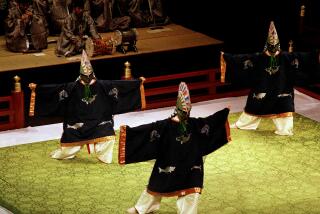OCPAC Vaults to Front of Line as a Principal Presenter of Dance
- Share via
In the ‘80s, dance aficionados had to get to the Music Center or the Shrine Auditorium to see American Ballet Theatre, the Bolshoi Ballet and other top-flight companies.
But as the Music Center receded as a dance presenter and the Shrine Auditorium fell out of favor with ballet audiences, dance geography has changed. Since the late ‘80s, the Orange County Performing Arts Center in Costa Mesa, which is presenting the Paris Opera Ballet tonight, has emerged as the primary destination for dance in Southern California.
For years, L.A. embraced the major ballet companies, especially when they were star-powered. But the stars aged, arts support from government and the private sector declined, and ballet audiences dwindled. In the early 1990s, the Joffrey Ballet and the Music Center ran into financial problems and administrative headaches trying to make a go of a residency deal. At the same time, the other resident companies that used the Dorothy Chandler Pavilion--Los Angeles Opera, the Los Angeles Philharmonic and the Los Angeles Master Chorale--wanted more stage time.
Still, OCPAC did not become the main presenter of classical dance in Southern California by default. It’s been by design, said Judith O’Dea Morr, OCPAC’s vice president of programming.
“The Orange County Performing Arts Center has been a major presenter of dance since we opened” in 1986, Morr said. “It was that commitment right from the very first season when our first company was New York City Ballet. That made a statement.”
In the beginning, it was a financial risk, however. Although OCPAC will not reveal what its dance budget is, unlike many other presenters, it supports companies by taking much--sometimes all--of the monetary risk involved.
“Through thick and thin, they’ve been our most faithful presenter,” said Kevin McKenzie, artistic director of American Ballet Theatre.
A financial arrangement has evolved over the years, according to McKenzie.
“Fifteen or 20 years ago, presenters would pay your fee. You’d go and dance, collect your fee and you’d go home. Now the fee doesn’t pay the costs. We have to fund-raise, and Orange County has to go out and fund-raise. We both have to find our own subsidies.”
Orange County is a bright spot on the dance landscape, said Jane Hermann, senior vice president and director of dance at ICM management in New York.
“The situation of presenting dance has seriously deteriorated. I don’t know why. It’s grim,” Hermann said.
“Without the Orange County Performing Arts Center, Paris Opera Ballet wouldn’t have come [to Southern California], and La Scala Ballet wouldn’t be coming [in July], and that’s just this year,” Hermann said.
“The Orange County center has an international reputation,” said David Eden, who produced Bolshoi engagements in June in Los Angeles and Orange County, “because of its consistency in bringing in world-class companies that sometimes other centers are not able to bring.”
Meanwhile, Los Angeles is showing signs of revival as a dance center. The Music Center will present Twyla Tharp Dance at the Ahmanson Theatre, June 21-24, and Music Center President Joanne Kozberg sees far more room for dance in the Dorothy Chandler Pavilion once Walt Disney Concert Hall opens in 2003.
Part of the Music Center’s plan to reestablish dance includes collaboration with the Orange County Performing Arts Center. The two facilities brought the Bolshoi in June 2000.
“Both of us sold out,” said Kozberg. “We sold out first, and Judy Morr said, ‘I never thought I would see the day when there was a sign at the Dorothy Chandler Pavilion box office saying, “If you want tickets, contact the Orange County Performing Arts Center.” ’ “
Both centers drove costs down with joint marketing and use of the Pacific Symphony in both places. “That cut down on rehearsal time,” Kozberg said.
Kozberg declined to specify how the Music Center was going to pay for revived dance programming.
“We have had a gift that will help us support dance, and we have significant sponsorship for dance,” she said. “I can’t give you a number, not now. There will be a presentation plan for the venues that will include it. That will take place probably by September.”
The problem of fitting dance into the schedule remains. “The resident companies,” Kozberg said, “are the lead tenants. When Disney Hall opens, the Dorothy Chandler Pavilion will primarily be a house for opera and dance.
Still, she said, “all the resident companies are very supportive. [And] the Ahmanson will continue to bring in dance, and the opera, too, is bringing in the Kirov.”
No matter what the Music Center does, OCPAC has no plan to cut back, and that’s music to the ears of artistic directors such as McKenzie.
“The truth is, there’s nothing that compares to Orange County’s sponsorship of us. It’s an annual event. That in itself speaks volumes. Personally, I love the theater. It feels like home.”
More to Read
The biggest entertainment stories
Get our big stories about Hollywood, film, television, music, arts, culture and more right in your inbox as soon as they publish.
You may occasionally receive promotional content from the Los Angeles Times.










